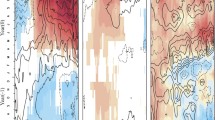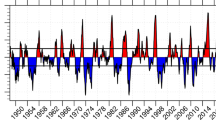Abstract
The frequency of Central Pacific (CP) El Niño occurrences has increased since the late 1990s. In spite of a wealth of studies, however, the physical mechanisms that have caused the change remain unclear. We hypothesize that atmospheric weather noise plays a role in these occurrences. To test this hypothesis, we conduct four simulations using Modular Ocean Model version 4 (MOM4) forced by atmospheric weather noise. In this study, the atmospheric weather noise is defined as the random noise obtained from the European Centre for Medium-Range Weather Forecasts atmospheric datasets. In the first experiment, MOM4 is forced by atmospheric weather noise before 1999 along with the corresponding climatological mean state. In the second experiment, MOM4 is forced by atmospheric weather noise after 1999 along with the corresponding climatological mean state. The third and fourth experiments are similar to the first two experiments except the time periods of the climatological mean state are switched. The results show that atmospheric weather noise may play a more important role than the climatological mean state in the increase of CP El Niño occurrences. This implies that the El Niño diversity could be caused by the modulation of atmospheric weather noise. Therefore, it is important to explore how the atmospheric weather noise might change in light of global warming.









Similar content being viewed by others
Change history
29 March 2017
An Erratum to this paper has been published: https://doi.org/10.1007/s00382-017-3613-1
References
Adcroft A, Hill C, Marshall J (1997) Representation of topography by shaved cells in a height coordinate ocean model. Mon Weather Rev 125:2293–2315
Ashok K, Behera SK, Rao SA, Weng H, Yamagata T (2007) El Niño Modoki and its possible teleconnection. J Geophys Res:Oceans 112:C11007
Bjerknes J (1969) Atmospheric teleconnections from the equatorial pacific 1. Mon Weather Rev 97:163–172
Blanke B, Neelin JD, Gutzler D (1997) Estimating the effect of stochastic wind stress forcing on ENSO irregularity. J Clim 10:1473–1486
Cai W et al (2015) ENSO and greenhouse warming. Nat Clim Change. doi:10.1038/NCLIMATE2743
Capotondi A et al (2015) Understanding ENSO diversity. Bull Am Meteorol Soc 96:921–938
Chen D, Lian T, Fu C, Cane MA, Tang Y, Murtugudde R, Zhou L (2015) Strong influence of westerly wind bursts on El Niño diversity. Nat Geosci 8:339–345
Chung P-H, Li T (2013) Interdecadal relationship between the mean state and El Niño types. J Clim 26:361–379
Dee D, Uppala S, Simmons A, Berrisford P, Poli P, Kobayashi S, Bauer P (2011) The ERA-interim reanalysis: configuration and performance of the data assimilation system. Q J R Meteorol Soc 137:553–597
Eisenman I, Yu L, Tziperman E (2005) Westerly wind bursts: ENSO’s tail rather than the dog? J Clim 18:5224–5238
Fedorov AV, Hu S, Lengaigne M, Guilyardi E (2015) The impact of westerly wind bursts and ocean initial state on the development, and diversity of El Niño events. Clim Dyn 44:1381–1401
Griffies SM, Harrison MJ, Pacanowski RC, Rosati A (2004) A technical guide to MOM4. GFDL Ocean Group Tech Rep 5:342
Griffies S, Gnanadesikan A, Dixon KW, Dunne J, Gerdes R, Harrison MJ, Spelman MJ (2005) Formulation of an ocean model for global climate simulations. Ocean Sci 1:45–79
Griffies SM, Schmidt M, Herzfeld M (2009) Elements of MOM4P1. GFDL Ocean Group Tech Rep 6:444
Hu S, Fedorov AV (2016) Exceptionally strong easterly wind burst stalling El Niño of 2014. Proc Natl Acad Sci 113:2005–2010
Hunke E, Dukowicz J (1997) An elastic-viscous-plastic model for sea ice dynamics. J Phys Oceanogr 27:1849–1867
Kao H-Y, Yu J-Y (2009) Contrasting eastern-Pacific and central-Pacific types of ENSO. J Clim 22:615–632
Kim JS, Kim KY, Yeh SW (2012) Statistical evidence for the natural variation of the central Pacific El Niño. J Geophys Res Oceans 117:C06014
Kirtman BP, Schopf PS (1998) Decadal variability in ENSO predictability and prediction. J Clim 11:2804–2822
Kug J-S, Jin F-F, An S-I (2009) Two types of El Niño events: cold tongue El Niño and warm pool El Niño. J Clim 22:1499–1515
Larkin NK, Harrison D (2005) On the definition of El Niño and associated seasonal average US weather anomalies. Geophys Res Lett 32:L13705
Lee T, Mcphaden MJ (2010) Increasing intensity of El Niño in the central–equatorial Pacific. Geophys Res Lett 37:L14603
Lee S, DiNezio P, Chung ES, Yeh SW, Wittenberg A, Wang C (2015) Spring persistence, transition and resurgence of El Nino. Geophys Res Lett 23:8578–8585
Lopez H, Kirtman BP (2013) Westerly wind bursts and the diversity of ENSO in CCSM3 and CCSM4. Geophys Res Lett 40:4722–4727
Lyon B, Barnston AG, DeWitt DG (2014) Tropical pacific forcing of a 1998–1999 climate shift: observational analysis and climate model results for the boreal spring season. Clim Dyn 43:893–909
McPhaden MJ (1999) Climate oscillation: genesis and evolution of the 1997–98 El Nino. Science 283:950–954
Mcphaden M, Lee T, Mcclurg D (2011) El Niño and its relationship to changing background conditions in the tropical Pacific Ocean. Geophys Res Lett. doi:10.1126/science.1132588
Newman M, Shin SI, Alexander MA (2011) Natural variation in ENSO flavors. Geophys Res Lett 38:L14705. doi:10.1029/2011GL047658
Philander S (1985) El Niño and La Niña. Atmos Res 42:2652–2662
Picaut J, Masia F, DuPenhoat Y (1997) An advective–reflective conceptual model for the oscillatory nature of the ENSO. Science 277:663–666
Ropelewski CF, Halpert MS (1987) Global and regional scale precipitation patterns associated with the El Niño/southern oscillation. Mon Weather Rev 115:1606–1626
Roulston MS, Neelin JD (2000) The response of an ENSO model to climate noise, weather noise and intraseasonal forcing. Geophys Res Lett 27:3723–3726
Takahashi K, Montecinos A, Goubanova K, Dewitte B (2011) ENSO regimes: reinterpreting the canonical and Modoki El Niño. Geophys Res Lett 38:L10704. doi:10.1029/2011GL047364
Tziperman E, Yu L (2007) Quantifying the dependence of westerly wind bursts on the large-scale tropical Pacific SST. J Clim 20:2760–2768
Tziperman E, Cane MA, Zebiak SE, Xue Y, Blumenthal B (1998) Locking of El Niño’s peak time to the end of the calendar year in the delayed oscillator picture of ENSO. J Clim 11:2191–2199
Winton M (2000) A reformulated three-layer sea ice model. J Atmos Ocean Technol 17:525–531
Wittenberg AT (2004) Extended wind stress analyses for ENSO. J Clim 17:2526–2540
Xiang B, Wang B, Li T (2013) A new paradigm for the predominance of standing central Pacific warming after the late 1990s. Clim Dyn 41:327–340
Yeh S-W, Jhun J-G, Kang I-S, Kirtman BP (2004) The decadal ENSO variability in a hybrid coupled model. J Clim 17:1225–1238
Yeh S-W, Kug J-S, Dewitte B, Kwon M-H, Kirtman BP, Jin F-F (2009) El Niño in a changing climate. Nature 461:511–514
Yeh S-W, Kirtman BP, Kug JS, Park W, Latif M (2011) Natural variability of the central Pacific El Nino event on multi-centennial timescales. Geophys Res Lett 38:L02704
Yeh S-W, Kug J-S, An S-I (2014) Recent progress on two types of El Niño: observations, dynamics, and future changes. Asia-Pac J Atmos Sci 50:69–81
Yeh S-W, Wang X, Wang C, Dewitte B (2015) On the relationship between the north Pacific climate variability and the central Pacific El Niño. J Clim 28:663–677
Yu J-Y, Kim ST (2010) Identification of central-Pacific and eastern-Pacific types of ENSO in CMIP3 models. Geophys Res Lett. doi:10.1029/2010GL044082
Yu J-Y, Kao P-K, Paek H, Hsu H-H, Hung C-W, Lu M-M, An S-I (2015) Linking emergence of the central Pacific El Niño to the Atlantic multidecadal oscillation. J Clim 28:651–662
Zhang R-H, Wang G, Chen D, Busalacchi A, Hackert E (2010) Interannual biases induced by freshwater flux and coupled feedback in the tropical Pacific. Mon Weather Rev 138:1715–1737
Author information
Authors and Affiliations
Corresponding author
Additional information
This paper is a contribution to the special collection on ENSO Diversity. The special collection aims at improving understanding of the origin, evolution, and impacts of ENSO events that differ in amplitude and spatial patterns, in both observational and modeling contexts, and in the current as well as future climate scenarios. This special collection is coordinated by Antonietta Capotondi, Eric Guilyardi, Ben Kirtman and Sang-Wook Yeh.
Rights and permissions
About this article
Cite this article
Lee, JW., Yeh, SW. & Jo, HS. Weather noise leading to El Niño diversity in an ocean general circulation model. Clim Dyn 52, 7235–7247 (2019). https://doi.org/10.1007/s00382-016-3438-3
Received:
Accepted:
Published:
Issue Date:
DOI: https://doi.org/10.1007/s00382-016-3438-3




